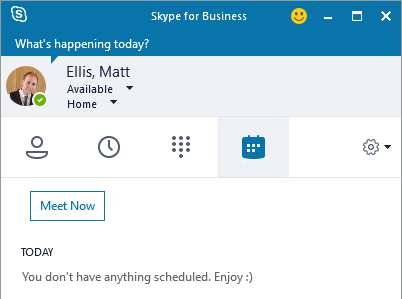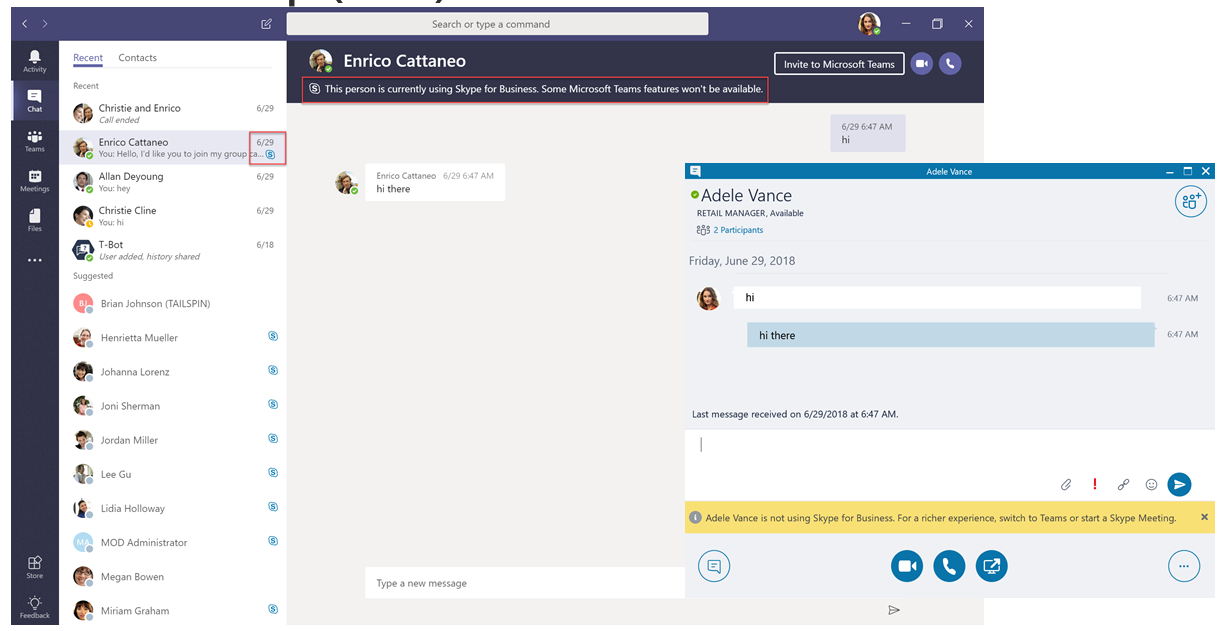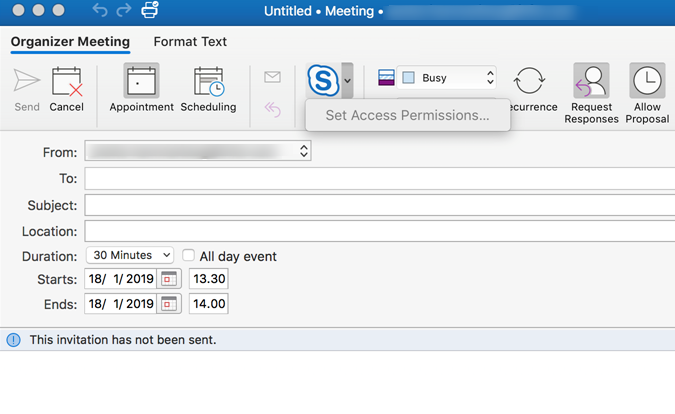- Linking Skype For Business With Mac Outlook Download
- Skype Add In For Outlook
- Linking Skype For Business With Mac Outlook
- Linking Skype For Business With Mac Outlook Free
- Skype For Business Outlook 2010
If your Outlook is not showing the Presence Icons (Green, Red, Blue… squares beside names) there are several possible issues:
UPDATE March 26 2020: SOLVED: Outlook Not Showing Teams Presence Icons

UPDATE January 18 2017 – If you have Mitel MiCollab make sure you read items 1 & 5.
1 – REGISTRY POINTS TO SOMETHING OTHER THAN SKYPE – LYNC
This was my issue. I recently installed Mitel MiCollab software had not noticed that the presence icons in Outlook had disappeared about the same time. The solution is to set the Registry back to looking to Skype – Lync for information:
First, open your Outlook Calendar and go to HOME on the ribbon above. Next, click NEW SKYPE MEETING. Outlook automatically loads a JOIN SKYPE MEETING link. This is the link your attendees will click on when it’s time for them to join the meeting. Skype for Business has additional features for licensing that your attendees can use. Conversation history can also be found in the Conversation tab in the Windows Skype for Business client client or the Chat tab on your Mac client. Where are voice mail messages or missed calls located? Voice mail messages and missed calls notifications (the caller hangs up before voice mail answers) are stored in the Outlook Inbox folder. When the Skype for Business client is installed on a computer it will automatically attempt to join using the full Skype for Business client, rather than Skype for Business Web App. In some cases the individual on the other end (the external user) may not have Skype for Business installed and they are unclear as to which client they should install. Step 1: Before you add a Skype meeting to Outlook, you must check if your Outlook already has the said add-in. To do so, click on File Options, and select Add-ins from the menu. You should notice. Get time back when you’re all caught up with what’s new in your Focused Inbox. Free with Outlook for iOS Connect. Get things done on the go with Outlook mobile. Work efficiently with email, calendar, contacts, tasks, and more—together in one place. Office integration lets you share.

- Open the Registry and expand HKEY_CURRENT_USER > SOFTWARE > IM PROVIDERS
- Set DEFAULTIMAPP to LYNC
- Restart Outlook
2 – REGISTRY HAS LYNC SET TO UNAVAILABLE
- Open the Registry and expand HKEY_CURRENT_USER > SOFTWARE > IM PROVIDERS > LYNC
- Set the UPANDRUNNING RegDWord to 2
- Open the Registry and expand HKEY_CURRENT_USER > SOFTWARE > IM PROVIDERS > COMMUNICATOR
- Set the UPANDRUNNING RegDWord to 0
- Restart Outlook
‘O’ = the number zero
Linking Skype For Business With Mac Outlook Download
A setting of “2” means that Lync / Skype is ready. Setting COMMUNICATOR to ‘0’ means that it is not available. See THIS for more details.
3 – SCREEN RESOLUTION STOPS PRESENCE ICONS
- Right Click on your desktop wallpaper and select DISPLAY SETTINGS
- Set CHANGE SIZE OF TEXT, APPS AND OTHER ITEMS to any of the following: 100% 125% or 150% .
- Restart Outlook
See THIS Microsoft article for more details.
4 – REGISTRY or POLICY HAS TURNED OFF PRESENCE
- Open the Registry and expand HKEY_CURRENT_USER > SOFTWARE > MICROSOFT > OFFICE > {x.0} > COMMON > IM
- Set the TurnOffPresenceIntegration DWord to 0
- Set the TurnOffPresenceIntegration DWord to 0
- Open the Registry and expand HKEY_CURRENT_USER > SOFTWARE > MICROSOFT > OFFICE > {x.0} > COMMON > PERSONALMENU
- Set the Enabled DWord to 1
- Restart Outlook
‘O’ = the number zero
See THIS Microsoft article for more details.
5 – Mitel MiCollab Changes the IM Provider Every Time It Starts
If you find that your presence icons in Outlook are missing after you have started up MiCollab, you need to change the following setting in MiCollab
- Click your name (top left corner of MiCollab window)
- Click CONFIGURATION
- Click CLICK TO CALL
- Uncheck ENABLE CALL THROUGH MICOLLAB CLIENT
This will stop MiCollab from changing the HKEY_CURRENT_USER > SOFTWARE > IM PROVIDERS setting.
Note that if you manually set the following key to zero (0), it will change the next time MiCollab is started and you will get frustrated.

HKEY_CURRENT_USER > SOFTWARE > IM PROVIDERS > MICOLLAB > UPANDRUNNING
If you really want to change the setting without using the MiCollab GUI, you can change the setting in the MiCollab configuration file:
C:Users<usersname>AppDataRoamingMitelUC<users account – email address>user.config
… scroll to the very bottom…
<setting name=”OutlookClickToCallEnabled”>
<value>False</value>
</setting>
</userSettings>
The Teams Meeting add-in lets users schedule a Teams meeting from Outlook. The add-in is available for Outlook on Windows, Mac, web, and mobile.
Teams Meeting add-in in Outlook for Windows
The Teams Meeting add-in is automatically installed for users who have Microsoft Teams and either Office 2013, Office 2016, or Office 2019 installed on their Windows PC. Users will see the Teams Meeting add-in on the Outlook Calendar ribbon.
Note
- There is no direct URL that links to the Teams add-in.
- There are additional considerations if your organization runs both Teams and Skype for Business. Under some circumstances, the Teams add-in is not available in Outlook. See Upgrade from Skype for Business to Teams for details.
- User permissions to execute the Regsvr32.exe file is a minimum requirement for the Teams Meeting add-in to be installed on the computer.
- If users do not see the Teams Meeting add-in, instruct them to close Outlook and Teams, then restart the Teams client first, then sign in to Teams, and then restart the Outlook client, in that specific order.
- If you are using an Office Outlook installation from the Microsoft Store, the Teams Meeting add-in isn't supported. Users who require this add-in are advised to install Click-to-Run version of Office, as outlined in Office on Windows 10 in S mode article.
Teams Meeting add-in in Outlook for Mac
The Teams Meeting button in Outlook for Mac will appear in the Outlook for Mac ribbon if Outlook is running production build 16.24.414.0 and later and is activated with a Microsoft 365 or Office 365 client subscription.
The meeting coordinates (the Teams join link and dial-in numbers) will be added to the meeting invite after the user clicks Send.
Teams Meeting add-in in Outlook Web App
The Teams Meetings button in Outlook Web App will appear as part of new event creation if the user is on an early version of the new Outlook on the web. See the Outlook Blog to learn about how users can try the early version of the new Outlook on the web.
The meeting coordinates (the Teams join link and dial-in numbers) will be added to the meeting invite after the user clicks Send.
Teams Meeting add-in in Outlook mobile (iOS and Android)
The Teams Meeting button shows up in latest builds of the Outlook iOS and Android app.
The meeting coordinates (the Teams join link and dial-in numbers) will be added to the meeting invite after the user clicks Send.
Teams Meeting add-in and FindTime for Outlook
FindTime is an add-in for Outlook that helps users reach consensus on a meeting time across companies. Once the meeting invitees have provided their preferred times, FindTime sends out the meeting invite on the user's behalf. If the Online meeting option is selected in FindTime, FindTime will schedule a Skype for Business or Microsoft Teams meeting. (FindTime will use whichever has been set by your organization as the default online meeting channel.)
Note
If you saved a Skype for Business setting in your Findtime dashboard, FindTime will use that instead of Microsoft Teams. If you want to use Microsoft Teams, delete the Skype for Business setting in your dashboard.
For more information, see Schedule meetings with FindTime.
Authentication requirements
The Teams Meeting add-in requires users to sign in to Teams using Modern Authentication. If users do not use this method to sign in, they'll still be able to use the Teams client, but will be unable to schedule Teams online meetings using the Outlook add-in. You can fix this by doing one of the following:
- If Modern Authentication is not configured for your organization, you should configure Modern Authentication.
- If Modern Authentication is configured, but they canceled out on the dialog box, you should instruct users to sign in again using multi-factor authentication.
To learn more about how to configure authentication, see Identity models and authentication in Microsoft Teams.
Enable private meetings
Allow scheduling for private meetings must be enabled in the Microsoft Teams admin center for the add-in to get deployed. In the admin center, go to Meetings > Meeting Policies, and in the General section, toggle Allow scheduling private meetings to On.)
The Teams client installs the correct add-in by determining if users need the 32-bit or 64-bit version.
Note
Users might need to restart Outlook after an installation or upgrade of Teams to get the latest add-in.
Teams upgrade policy and the Teams Meeting add-in for Outlook
Customers can choose their upgrade journey from Skype for Business to Teams. Tenant admins can use the Teams co-existence mode to define this journey for their users. Tenant admins have the option to enable users to use Teams alongside Skype for Business (Islands mode).
When users who are in Island mode schedule a meeting in Outlook, they typically expect to be able to choose whether to schedule a Skype for Business or a Teams meeting. In Outlook on the web, Outlook Windows, and Outlook Mac, users see both Skype for Business and Teams add-ins when in Islands mode by default. You can configure a Teams meeting policy setting to control whether users in Islands mode can only use the Teams Meeting add-in or both the Teams Meeting and Skype for Business Meeting add-ins.
Skype Add In For Outlook
Due to certain limitations in the initial release, Outlook mobile can only support creating Skype for Business or Teams meetings. See the following table for details.
| Coexistence mode in the Teams admin center | Default meetings provider in Outlook mobile |
|---|---|
| Islands | Skype for Business |
| Skype for Business only | Skype for Business |
| Skype for Business with Teams collaboration | Skype for Business |
| Skype for Business with Teams collaboration and meetings | Teams |
| Teams only | Teams |
Set whether users in Islands mode can only use the Teams Meeting add-in or both the Teams Meeting and Skype for Business Meeting add-ins
As an admin, you can configure a Teams meeting policy setting to control which Outlook meeting add-in is used for users who are in Islands mode. You can specify whether users can only use the Teams Meeting add-in or both the Teams Meeting and Skype for Business Meeting add-ins to schedule meetings in Outlook.
You can only apply this policy to users who are in Islands mode and have the AllowOutlookAddIn parameter set to True in their Teams meeting policy. For steps on how to set this policy, see set the meeting provider for users in Islands mode.
Other considerations
The Teams Meeting add-in is still building functionality, so be aware of the following:
- The Teams Meeting add-in requires an Exchange mailbox for the primary user scheduling the meeting. Ensure that you have at least one Exchange mailbox configured in your Outlook profile and use it to schedule Teams meetings with the add-in. For Exchange requirements, see How Exchange and Teams interact.
- The add-in is for scheduled meetings with specific participants, not for meetings in a channel. Channel meetings must be scheduled from within Teams.
- The add-in will not work if an Authentication Proxy is in the network path of the user's PC and Teams Services.
- Users can't schedule live events from within Outlook. Go to Teams to schedule live events. For more information, see What are Microsoft Teams live events?.
Learn more about meetings and calling in Microsoft Teams.
Troubleshooting
Use the following steps to troubleshoot issues with the Teams Meeting add-in.
Teams Meeting add-in in Outlook for Windows does not show
If you cannot get the Teams Meeting add-in for Outlook to install, try these troubleshooting steps.
Download and run the Microsoft Support Recovery Assistant to perform automated troubleshooting steps and fixes.
Alternatively, perform the following steps manually:
- Windows 7 users must install the Update for Universal C Runtime in Windows for the Teams Meeting add-in to work.
- Check that the user has a Teams Upgrade policy which enables scheduling meetings in Teams. See Upgrade from Skype for Business to Teams for more details.
- Check that the user has a Teams Meeting policy that permits the Outlook Add-in. See Manage meeting policies in Teams for more details.
- Ensure the user has the Teams desktop client installed. The meeting add-in will not be installed when only using the Teams web client.
- Ensure the user has Outlook 2013 or later installed.
- Make sure the user has permission to execute regsvr32.exe.
- Ensure that all available updates for Outlook desktop client have been applied.
- Follow these steps:
- Restart the Teams desktop client.
- Sign out and then sign back in to the Teams desktop client.
- Restart the Outlook desktop client. (Make sure Outlook isn't running in admin mode.)
If you still don't see the add-in, make sure that it isn't disabled in Outlook.
- In Outlook, choose File and then Options.
- Select the Add-ins tab of Outlook Options dialog box.
- Confirm that Microsoft Teams Meeting Add-in for Microsoft Office is listed in the Active Application Add-ins list
- If the Teams Meeting Add-in is listed in the Disabled Application Add-ins list, select COM Add-ins in Manage and then select Go…
- Set the checkbox next to Microsoft Teams Meeting Add-in for Microsoft Office.
- Choose OK on all dialog boxes and restart Outlook.
For general guidance about how to manage add-ins, see View, manage, and install add-ins in Office programs.
Linking Skype For Business With Mac Outlook
If the add-in still does not show, use the following steps to verify the registry settings.
Note
Incorrectly editing the registry may severely damage your system. Before making changes to the registry, you should back up any valued data on the computer.

- Launch RegEdit.exe
- Navigate to HKEY_CURRENT_USERSoftwareMicrosoftOfficeOutlookAddins
- Verify TeamsAddin.FastConnect exists.
- Within TeamsAddin.FastConnect, verify LoadBehavior exists and is set to 3.
- If LoadBehavior has a value other than 3, change it to 3 and restart Outlook.

Delegate scheduling does not work
Linking Skype For Business With Mac Outlook Free
If your administrator has configured Microsoft Exchange to control access to Exchange Web Server (EWS), a delegate won't be able to schedule a Teams meeting on behalf of the boss. The solution for this configuration is under development and will be released in the future. As a workaround, your administrator can add the following string to the EWS Allow List: 'SchedulingService'.
Skype For Business Outlook 2010
Related topics
